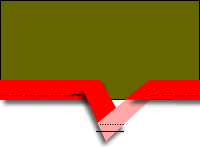Quilting How-To: Binding a Quilt
This how-to is for a double binding. I believe they are the easiest
and look the most professional.
This how-to
covers binding a quilt with straight edges where a straight grain binding
can be used. A quilt with curved edges needs a bias binding.
I use a method similar to my friend Glenna. She has a useful video
for how to bind a wall hanging as well
as a
tool for making corners
.
Step 1: Prepare the Binding
- I like to use a 2 inch strip for bindings. Choose a size between 1 ¾ inch and 2 ½
inches.
- Use the MyWebQuilter.com
Binding Calculator
to determine how many strips are required for the binding.
- Join all binding strips together in one long strip using mitered
seams. Place two strips right sides together at right angles to each other.
Mark and then sew on the diagonal as shown below. Using a few pins to make
sure the strips stay aligned is a good idea. Trim off corner ¼ inch from
seam. Press seams open.
- Align raw edges of binding with the front middle lower edge
of the trimmed, squared up quilt.
Step 2: Sew Binding to Quilt
- Use an even-feed or walking foot for the best results.
- Begin stitching using a ¼ inch seam leaving an unstitched tail of at least
5 inches.
- Back stitch at the start.
- It is ok to use 1 or 2 pins to hold the binding to the quilt where you
will start sewing. Do NOT pin the entire side or binding.
- Stop sewing 2-3 inches before the corner with the needle down and mark the corner ¼ inch from each side and a 45º line to the corner.
- Continue stitching up to the marked point ¼ inch from the corner. Stop
with the needle down. Rotate the quilt 45º and sew out to the corner.
- Clip the threads and remove quilt from sewing machine.
- Fold binding away from the quilt forming a
45º angle in binding.
- Fold binding down aligning second fold with the edge of the quilt.
- If necessary use one pin to hold binding near the corner.
- Sew starting at the edge of the quilt forming a mitered pleat at the corner.
- Continue around the quilt until all 4 corners are complete.
- Stop sewing about 5 inches from the starting point removing quilt from sewing
machine.
- Lay the binding flat against the quilt overlapping the tails on the binding.
- Near the middle of the unsewn section measure and cut the binding overlap to be exactly
equal to the cut width of the binding. So for a 2 inch cut binding the
overlap should be exactly 2 inches.
- Pull the binding tails away from the quilt, open them to their full width and
place right sides together at right angles to each other.
- Mark the diagonal across the corner of the binding tails and sew on this
diagonal.

- Hints:
- Scrunch up or fold the quilt around the unsewn area to get the tails to meet.
- Use numerous pins
to hold the tails together
- Change from your walking foot to a straight stitch
foot on your sewing machine
- Test that you have sewn the seam correctly by re-folding binding lengthwise and
placing it on the edge of the quilt. You should have a nice
mitered seam. (It is very easy to accidentally twist the tails or sew the
wrong corner!)
- If your binding passes this test, trim off seam across the corner to
¼ inch and press seam open.
- Re-fold the binding lengthwise, place on edge of quilt and sew the remaining raw
edges to the quilt.
- Fold the binding to the back of quilt. Hand stitch the binding fold to the
quilt using a blind stitch. The video below demonstrates this step.
- I typically use a few pins when hand stitching but it is NOT necessary to pin
around the entire quilt prior to starting the hand stitching. Pin a small
section, sew that section, pin next small section, etc.
- Form a miter at each corner. Stitch the miter shut for a polished look.